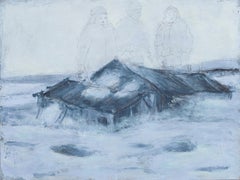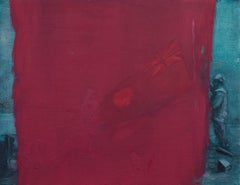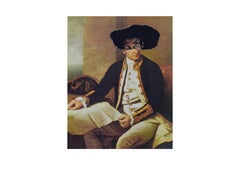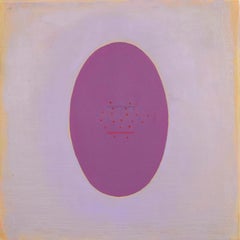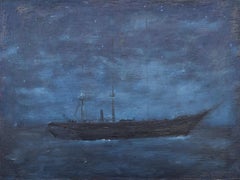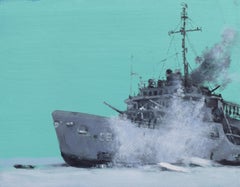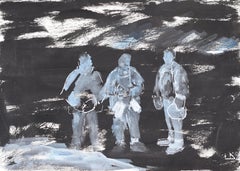Jessica Houston
American, b. 1970
Jessica Houston (MA, Columbia University) has traveled from pole to pole, using color and light to entangle and provoke questions related to our changing natural world, and our nature within it. She has created site-specific works for the NJ MOCA (NJ); the Castello di Corigliano (Puglia, Italy); and The Albany Airport (Albany, NY). Select exhibitions include Art Mûr Gallery, Montréal, Canada; The Hyde Collection Museum, Glens Falls, NY; and The Latimer House Museum, New York, NY. She has been invited to residencies at The Albers Foundation and CAMAC Center for Art, Science and Technology in France. Her works are funded by The Canada Council for the Arts and are in the collections of La collection Prêt d’œuvres d’art, Musée National Des Beaux-Arts du Quebec; Bibliothèque et Archives nationales du Québec (BAnQ), Montréal, Québec; Bank of Montréal, Toronto; and the Consulate General of Monaco, Montréal. She has lectured at The Art Institute of Florence; Columbia University; Concordia University; and OCAD University.(Biography provided by Art Mûr)
| Styles |
| Materials |
| Related Artists |
Eight Adélie Penguins...
By Jessica Houston
Located in Montreal, Quebec
“Eight Adélie Penguins immediately came to greet us … They insisted on us going to visit Hut Point, where the large structure built by Captain Scott’s pa...
Category
2010s Contemporary Jessica Houston
Materials
Oil, Wood Panel
To Hang In Between
By Jessica Houston
Located in Montreal, Quebec
A group of figures heads for icy distant mountains. A familiar enough scene of polar explorers hauling their sledges. Yet somehow this does not quite fit the heroic mold. The ice and...
Category
2010s Contemporary Jessica Houston
Materials
Oil, Wood Panel
Drawing in Water
By Jessica Houston
Located in Montreal, Quebec
A group of figures heads for icy distant mountains. A familiar enough scene of polar explorers hauling their sledges. Yet somehow this does not quite fit the heroic mold. The ice and sky are tinged a movie musical pale blue and their gear is a bit too colorful for the era of man-hauling. And then there’s the sled, piled high not with boxes of supplies but with a jumbled heap of antiquities: Greek Athenas, bits of a coliseum, a ship’s great wheel. In Jessica Houston’s collage “The Long Haul,” the explorers drag history itself into the great beyond, their backs turned from their absurd load. But we take in the entire scene.
In her suite of works, Over the Edge of the World, Houston uses oil on wood, ink on paper, and collages of found images, many from National Geographic Magazine, to rearrange the evidence – and thus history’s possibilities.
Houston joins visual artists such as Judit Hersko, Katja Aglert, and Isaac Julien who have been inspired by the explorers of the past. Like them, she draws, in part, on the singular tradition of polar exploration narratives as well as fictions such as Ursula Le Guin’s “Sur” (1981), a utopian feminist hoax in which a party of South American women reach the South Pole in 1909, two years before the official arrival of European explorers. Le Guin’s explorers do not feel compelled to leave any written record or physical proof of their presence at the South Pole. If Le Guin’s women might have made it, what other traces have been missed?
Collage can work alongside alternative history: it interprets, interrupts, and rearranges. It questions the completed whole, instead emphasizing composition and relation. Collage suggests it all might be … otherwise. Houston’s collages flaunt their second nature. Yet what they show remains somehow plausible. You want to believe what you’re beginning to see.
In “A life Attuned to Larger Rhythms” Houston grids out rectangles of captured images to overwhelm the eye as the polar environment itself might (whiteout is a paradoxical species of optical overstimulation). Through the strangely ordered confusion of an ice survey grafted atop a chessboard, the mind begins to recognize new connections, emergent shapes: a different future? In “Launching Strategy” a yellow-orange pyramid balances garishly atop a tent. Which came first, the realist tent or the Platonic shape? Can we ever be sure that we’re not already seeing through premade abstractions? Or is it that baggage we’ve been dragging along?
In “Architecture of the Anthropocene” and “Red Blood, Red Earth” Houston reroutes visually symbolic through-lines between women and non-European people and the official history in which they appear dimly or not at all. A full-skirted woman holds onto the tether of a kite that seems to pull her upwards towards a weather balloon floating above an Antarctic base’s radio tower; a row of tropical workers wielding pickaxes folds into the trajectory of a sailor aiming a bow and arrow at an iceberg stained with red. These are not people or images normally associated with polar discovery. But shouldn’t they matter?
“Territory Over Land” strips in a scene from a painted depiction of the tropics, possibly from one of Captain James Cook’s circumnavigations. “Captain Cook’s Legacy” more directly confronts an official portrait of Cook with the torn-in eyes from what can only be described as the explorer’s anonymous dark Other. The hybrid portrait is a kind of contact zone. “Henson and Peary – Past Entanglements” is a cooler, less volatile twin portrait of disputed discoverer of the North Pole Robert Peary...
Category
2010s Contemporary Jessica Houston
Materials
Ink, Archival Paper
Captain Cook’s Legacy
By Jessica Houston
Located in Montreal, Quebec
A group of figures heads for icy distant mountains. A familiar enough scene of polar explorers hauling their sledges. Yet somehow this does not quite fit the heroic mold. The ice and...
Category
2010s Contemporary Jessica Houston
Materials
Archival Paper, Magazine Paper
Action Which Enables Us to Project Our Forces Into the Outside World
By Jessica Houston
Located in Montreal, Quebec
A group of figures heads for icy distant mountains. A familiar enough scene of polar explorers hauling their sledges. Yet somehow this does not quite fit the heroic mold. The ice and...
Category
2010s Contemporary Jessica Houston
Materials
Oil, Wood Panel
Of the return voyage...
By Jessica Houston
Located in Montreal, Quebec
“Of the return voyage there is nothing to tell… In 1912 all the world learned that the brave Norwegian Amundsen had reached the South Pole; and then, much l...
Category
2010s Contemporary Jessica Houston
Materials
Oil, Wood Panel
The Sky Was A Doorway
By Jessica Houston
Located in Montreal, Quebec
A group of figures heads for icy distant mountains. A familiar enough scene of polar explorers hauling their sledges. Yet somehow this does not quite fit the heroic mold. The ice and...
Category
2010s Contemporary Jessica Houston
Materials
Oil, Wood Panel
The Fatigue of the Conquest
By Jessica Houston
Located in Montreal, Quebec
A group of figures heads for icy distant mountains. A familiar enough scene of polar explorers hauling their sledges. Yet somehow this does not quite fit the heroic mold. The ice and sky are tinged a movie musical pale blue and their gear is a bit too colorful for the era of man-hauling. And then there’s the sled, piled high not with boxes of supplies but with a jumbled heap of antiquities: Greek Athenas, bits of a coliseum, a ship’s great wheel. In Jessica Houston’s collage “The Long Haul,” the explorers drag history itself into the great beyond, their backs turned from their absurd load. But we take in the entire scene.
In her suite of works, Over the Edge of the World, Houston uses oil on wood, ink on paper, and collages of found images, many from National Geographic Magazine, to rearrange the evidence – and thus history’s possibilities.
Houston joins visual artists such as Judit Hersko, Katja Aglert, and Isaac Julien who have been inspired by the explorers of the past. Like them, she draws, in part, on the singular tradition of polar exploration narratives as well as fictions such as Ursula Le Guin’s “Sur” (1981), a utopian feminist hoax in which a party of South American women reach the South Pole in 1909, two years before the official arrival of European explorers. Le Guin’s explorers do not feel compelled to leave any written record or physical proof of their presence at the South Pole. If Le Guin’s women might have made it, what other traces have been missed?
Collage can work alongside alternative history: it interprets, interrupts, and rearranges. It questions the completed whole, instead emphasizing composition and relation. Collage suggests it all might be … otherwise. Houston’s collages flaunt their second nature. Yet what they show remains somehow plausible. You want to believe what you’re beginning to see.
In “A life Attuned to Larger Rhythms” Houston grids out rectangles of captured images to overwhelm the eye as the polar environment itself might (whiteout is a paradoxical species of optical overstimulation). Through the strangely ordered confusion of an ice survey grafted atop a chessboard, the mind begins to recognize new connections, emergent shapes: a different future? In “Launching Strategy” a yellow-orange pyramid balances garishly atop a tent. Which came first, the realist tent or the Platonic shape? Can we ever be sure that we’re not already seeing through premade abstractions? Or is it that baggage we’ve been dragging along?
In “Architecture of the Anthropocene” and “Red Blood, Red Earth” Houston reroutes visually symbolic through-lines between women and non-European people and the official history in which they appear dimly or not at all. A full-skirted woman holds onto the tether of a kite that seems to pull her upwards towards a weather balloon floating above an Antarctic base’s radio tower; a row of tropical workers wielding pickaxes folds into the trajectory of a sailor aiming a bow and arrow at an iceberg stained with red. These are not people or images normally associated with polar discovery. But shouldn’t they matter?
“Territory Over Land” strips in a scene from a painted depiction of the tropics, possibly from one of Captain James Cook’s circumnavigations. “Captain Cook’s Legacy” more directly confronts an official portrait of Cook with the torn-in eyes from what can only be described as the explorer’s anonymous dark Other. The hybrid portrait is a kind of contact zone. “Henson and Peary – Past Entanglements” is a cooler, less volatile twin portrait of disputed discoverer of the North Pole Robert Peary...
Category
2010s Contemporary Jessica Houston
Materials
Ink, Archival Paper
Browse all Art from Jessica Houston
Shop NowArtists Similar to Jessica Houston
Jessica Houston art for sale on 1stDibs.
Find a wide variety of authentic Jessica Houston art available for sale on 1stDibs. If you’re browsing the collection of art to introduce a pop of color in a neutral corner of your living room or bedroom, you can find work that includes elements of blue, purple, orange and other colors. You can also browse by medium to find art by Jessica Houston in oil paint, paint, panel and more. Much of the original work by this artist or collective was created during the 21st century and contemporary and is mostly associated with the contemporary style. Not every interior allows for large Jessica Houston art, so small editions measuring 9 inches across are available. Customers who are interested in this artist might also find the work of John Baker, Audrey Anastasi, and Amy Smith. Jessica Houston art prices can differ depending upon medium, time period and other attributes. On 1stDibs, the price for these items starts at $1,100 and tops out at $7,200, while the average work can sell for $1,900.
